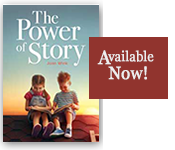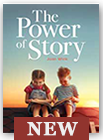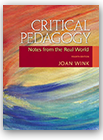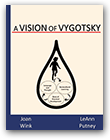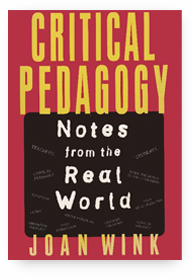Except from:
Wink, J. (2004, 3/e, pp.123-129) Critical Pedagogy: Notes from the REAL WORLD. Boston, MA: Allyn & Bacon.
In transformative education, the spirit of inquiry leads the search for meaning. Students need to have classrooms in which they are safe to take risks. In this pedagogical model, teachers shift from control of knowledge to creation of processes whereby students take ownership of their learning and take risks to understand and apply their knowledge. Students and teachers come to realize that their actions can make a difference.
Problem Posing: Jonathan and Wyatt, Examples from the Community
How to do critical pedagogy? Let’s reflect together on Jonathan, the student I mentioned in Chapter 1. Why is it that I could learn so much about teaching and learning from him? Was I doing critical pedagogy? Problem posing is central in critical pedagogy; what does problem posing have to do with Jonathan?
Paulo Freire has taught that to teach and learn critically we can follow this straightforward guideline: to name, to reflect critically, to act. I have found this to be extremely effective in my own teaching and learning. However, I also have discovered that sometimes educators are doing/living this framework without realizing it. I also have discovered that when we ask teachers and learners to name the problem, they respond, “What?” Sometimes, I suspect that when I ask students to name, they think that I talk funny. When we name a problem or a situation, we are doing nothing more than conceptualizing critically and articulating clearly.
Let’s rethink the experiences of Jonathan and Wyatt using this framework as a guide for our own reflection.
To name. In the Jonathan story, to name would be to say that he could not decode and encode; he could not read and write as they have traditionally been defined. In the Wyatt story, he did not start reading at the prescribed time, nor with the “proper” books. Only Pokémon and Captain Underpants cracked his reading code.
To reflect critically. What did we do to reflect critically about Jonathan and Wyatt? We listened, watched, talked, read, and thought. In addition, the two sets of parents kept reading with their sons, as they tried not to share their growing concern. What did Jonathan and Wyatt do? They tried and tried, and sometimes they cried.
To act. What did Jonathan’s parents do? They enrolled Jonathan in an expensive program, which was very much the opposite of anything that I had recommended. What did Wyatt’s parents do? They recognized that Wyatt was learning to decode with reading materials which they found offensive. What did I do? I just kept writing with the hope that others can learn from these experiences.
During all of this time, did I ever think that I was doing critical pedagogy? Never. Not once. Was I doing critical pedagogy? Probably, but I prefer to think that I was simply living my beliefs. I care about Jonathan; I care about Wyatt; I care about children learning to read; I care about teaching and learning. I just had to keep a close eye on all of this. I couldn’t stop myself.
However, I suspect one has constantly and critically to reflect on learning, relearning, and unlearning. This is the hard part.
Here’s the point: I believe that many educators are doing the very same thing in their own educational context. Every day with my work with teachers, I observe similar powerful situations. Every night in my graduate classes, I hear incredible stories of teachers and students and families. At the grass roots level, teachers are making a difference in the lives of students. But, I suggest that it is helpful to stop thinking of ourselves as just methodologists. We are more than that: Critical pedagogy enables us to understand that we also are professionals and intellectuals who have the power to take part actively in self- and social transformation. Critical pedagogy makes us keep on keeping on.
Problem Posing: Miss Johnson, an Example from Secondary Schools
I have stated that all activities in this chapter are designed to be used in the classroom and/or the community. It is how and why we do activities that make them critical. In the following vignette, we see how Miss Johnson turned her classroom into a community with critical activities. This all took place many years ago, so I am sure that Miss Johnson had never heard of critical pedagogy, but she was doing it.
Sometimes when we try to define problem posing, it can be helpful to reflect on our own teaching and learning. I learned about Miss Johnson from Terry, a teacher and graduate student. Terry discovered the meaning of problem posing by thinking of her own experiences:
Problem posing always makes me think of liberation. If the purpose of education truly is human liberation, then why are we always trying to box in ideas? We are always trying to fit powerful ideas into a scope and sequence, a curriculum, a skill continuum, or another district-mandated process. Problem posing cannot be confined to these boxes. When I think of liberated people, I think of Maya Angelou. who flies above all the boxes that others have created.
I think of my high school literature teacher, Miss Johnson. In her class, we lived problem posing every day, and we didn’t even know it. She opened the world for us; she hated syllabi. Her enthusiasm ignited our journeys of learning. We had tons of books of all kinds in her class, and we had time to read whatever we chose. We read and talked and discussed and wrote. And, we created a community in the process.
Miss Johnson listened to our hidden voices. She taught us to listen to each other. We learned that any problem could have many solutions.
She taught us to name; to reflect critically; and to act. I particularly remember one of the problems we posed.
To name. This was during the 1960s, and the girls were not allowed to wear pants to school. We were angry about this. We used to go to her room and talk about it. In her class, we knew that we could name anything we wanted. We just didn’t know that we were naming!
To reflect critically. We spent many lunch periods in her classroom talking about our anger. She would listen to each of us. If it mattered to us, it mattered to her.
To act. After considering several options, we devised a plan that was very radical in those days. We wrote letters and carried them to the student council, the administration, and the school board to ask that girls be allowed to wear pants to school. I remember the boys on the student council, the male administrators, and the men on the school board saying no: Girls had to wear dresses. However, the year after we graduated, pants were allowed for all students.
Apparently, I have overlooked a significant event in the histories of women of my age. The same week that Terry wrote this reflection, another grad student/teacher handed in a splendid timeline that reflected the educational changes from Comenius to Freire. On this timeline she had written: “1966-girls finally were allowed to wear pants to school.”
Principles of Problem Posing
Teachers and Learners
- Trust each other
- Believe that their involvement will matter
- Understand resistance and institutional barriers to change
- Are aware of their own power and knowledge
If we look back on Terry’s experience, we can see that these principles of problem posing were embedded in this process. For example, the students and teacher trusted each other, they believed that they could change the dress code; they knew the student council members, the administrators, and school board would probably say no initially; and they had a sense that they could make a difference because, after all, the dress code did affect their lives every day. It had very little effect on those who had created the rule. Maybe perseverance should be another principle of problem posing.
The Teacher’s Role in Problem Posing
- To create a safe place for it to happen
- To ask hard questions for the students’ musing
- To assist students with codification
Miss Johnson opened her classroom during lunch and after school. Terry and her friends knew they were welcome. As the girls talked, Miss Johnson periodically would ask questions that they had never considered. For example, who made this rule about pants? Miss Johnson had suggested to the girls that they write letters with their concerns; she had led them into the act of codification. As I have written previously, codification is the problem represented in some format. What might this codification look like? It can be captured in clay, in paint, in chalk, in pencil, in music, in any art form. In the process of problem posing, the learners capture their feelings and meanings about a problem.
Problem Posing: Stephanie, an Example from the Primary Grades
Stephanie listened as her students discussed their frustration with never being able to open the containers of applesauce that were served at lunch. The students consistently had to ask a teacher or an aide to open the containers for them. Instead of dismissing this topic as irrelevant because it was outside of the prescribed curriculum, Stephanie recognized the dynamic as one that mattered to students. As the students talked, Stephanie wrote their comments on the chalkboard. Stephanie allowed time for the students to articulate and conceptualize the problem. After the students had clearly named their problem, she asked them what could be done to alleviate this problem. The suggestions began as Stephanie continued to capture all the thoughts and language on the chalkboard. Finally, the group came to a consensus. They decided to write a class letter to the company. With the language on the board, the students were able to write independently to express their concerns. When we last called Stephanie, she reported the letters had been mailed and they were awaiting a reply.
Doing critical pedagogy is grounded in some form of Freire’s legacy of problem posing. In this case, Stephanie and the students recreated their socially generated knowledge to act upon one small condition of their own world. The transformative lesson design encourages students to act on their knowledge, and it seeks to create processes whereby students can see that their actions do count. Learning and teaching are integrated for self- and social transformation.
Problem Posing: Codification
Freeman and Freeman (1998, 1992) have clarified problem posing for many teachers whom I know, and they credit Wallerstein (1983) with expanding their understanding. Their codification model is grounded in the work of Freire and is amplified for teachers’ ease in implementation. It has been my experience that many teachers are ready to pose problems; however, it is challenging, and they often are confused about codification. Freeman and Freeman (1992) offer the following model of codification:
- The code is a whole story, picture, or film.
- The code is based on the learners’ lives.
- Learners identify and solve real-life problems.
- Learners work cooperatively to solve community problems.
- The goal is literacy for the learners.
- The goal is for teachers and students to empower themselves. (p. 112)
Freeman and Freeman (1992) extend their codification processes to their version of problem posing in which they offer six phases. Adapting their model, I offer the following four phases of problem posing:
1. Begin with the student’s own experience. In schools, we are so focused on doing, on covering, that we don’t take time to think, to reflect; to muse. My sense is that we, as teachers, have failed our students by not taking the time to encourage them to reflect quietly on their lived experiences. Yes, learning can take place in noisy, interactive classrooms. Learning can also take place when we silently reflect. I have often heard Yetta Goodman, who teaches at the University of Arizona, say that the only thing teachers hate more then noise is silence. She is right.
2. Identify, investigate, pose a problem within your own life. At this point, teachers need to let go of control; student-centered learning is about to begin. Students generate knowledge about the problem; they brainstorm where, when, and how they can learn more about it. Students set out to learn what they want to know. They codify ideas; they interview experts in the community; they find information in the library, through technology, from any resource that has accessible information. Teachers can facilitate this process by helping students find language to conceptualize and articulate their thoughts. Teachers ask leading questions about resources for more learning and possible connections to students’ lives. Teachers stay out of the way.
3. Solve the problem together. After conceptualizing, articulating, and researching the problem, learners work together to solve the problem.
4. Act. Learners make a plan and act on it. Learners discover that their learning and their involvement really does matter. Learners are empowered by their own learning and action. They realize that their social interaction can lead to self- and social transformation.
Problem posing always ends with action. Once the learners have identified and captured (named) their concern, they take action, find solutions, extend the dialogue of the classroom to the real world. What might this action look like? It can be writing a letter to the editor, governor, legislators, or presidents; interviewing others; recording oral histories; meeting with policy-making committees; cleaning up a community; or beginning an environmental, social, cultural, or political action group.
Problem Posing: Reggie, an Example from Postsecondary
Reggie, a former drop-out and now a college freshman, was enrolled in a writing seminar. Although he was a bright student, every week in writer’s workshop, Reggie sat. He rarely finished more than a paragraph.
To name. Reggie would not write. Although he had returned to school, he was still angry and refusing to grow and learn and develop. His oppositional behaviors in the writers’ workshop were holding back the further development of his own literacy. However, Reggie cared about his own writing and wanted to improve.
The instructor tried many different approaches to get Reggie to write. Nothing seemed to work. Finally, the instructor arranged learned of a method referred to as voiced writing at the local university.
To reflect critically. The instructor tried many different approaches; she discussed Reggie with her colleague and local university professors. The instructor did not give up; she continued to reflect, not only on reasons why Reggie was not writing, but also how she might get him to want to improve his writing.
Finally, the instructor arranged for a tutor to come to writers’ workshop to work with Reggie by himself. The instructor helped Reggie to understand the work that was necessary to pass the class, because Reggie said that he did want to successfully finish the class. The tutor agreed to learn the method of voiced writing so that he could try it with Reggie.
To act. The instructor found a tutor and another method, voiced writing, to try with Reggie.
Ultimately, the human relationship between Reggie and the tutor is what brought about the transformation. The tutor discovered that Reggie could not write silently, but he could write if he spoke aloud as he wrote. “Silence him, and he cannot write,” the tutor told the instructor. After working with a partner and “talking” his own writing, Reggie discovered that he, indeed, could write. He simply needed to talk as he wrote.
There are many variations of voiced writing. The process that the instructor followed with Reggie is as follows:
- Reggie was paired with one other student, Lee.
- First, Reggie talked the writing assignment while Lee wrote verboten every word which Reggie said.
- Second, Reggie read aloud what Lee had written.
- Third, Reggie and Lee exchanged roles. Lee talked the assignment, and Reggie wrote every word, that she said.
- Fourth, Lee read aloud what she had written.
- Finally, after Reggie and Lee had done this activity several times, they each returned to their own desks and continued to talk (quietly) and write their own words.
In other words, if you can talk, you can write. Just talk as you write.
As with all methods, how they are used and why they are used are basic to determining whether the process will be effective with students. And as with all methods, there are as many variations as there are needs of students. In what follows, I am sharing two other ways of approaching this activity.
The following activity might work well for students who are preparing for discrete point grammar tests. We teach grammar for 12 years in a row, and students still say, “I don’t know grammar,” which raises many disturbing questions about meaningful teaching and learning and types of assessment. However, this activity can demonstrate to them that they do know grammar – it’s all in their head; they just have to talk it. Repeat the voiced writing activity, but have the pairs of students talk (and record) their oral responses on grammar exercises. Often, students will talk the isolated grammar exercises correctly. It demonstrates to the students that many do have correct grammar in our heads; we hear it on TV, on the radio, and from teachers. Students acquire a lot of correct grammar in this way and don’t realize that they know it.
A second variation to use when confronted with students who say they can’t write is to use this same paired activity and focus the talk to a description of the worst teacher they ever had. First, ask them to muse (think of sharp mental images, visualize, feel the memory). Second, the talk student begins to brain dump — just saying all the images and words that are in their head; the writer records every word. Third, the talk student uses these words to talk about that teacher; the writer writes everything. The talk student reads to the writer what has been written, and they exchange roles. This activity of muse, brain dumping, and writing is much more powerful than it looks on paper, but students (of all ages) have to be walked through it the first few times. During the musing phase, the teacher must encourage the students to think in pictures and sense or visualize every aspect. During the brain-dumping phases, students just take the visual images and use words to describe them. During the writing phase, the students use their own language to generate their own cognition. Good problem posing always revolves around concepts that the learners care deeply about or have experienced.
In summary, problem posing takes place when people begin with a spirit of inquiry and questioning of situations that directly affect their own lives. Problem posing ends with actions and transformations in their lives and in their context. Problem posing begins again.
Here is the secret: If you do critical pedagogy, you will be problem posing. To problem pose is to name, to reflect critically, and to act. There you have it: how to do critical pedagogy.
